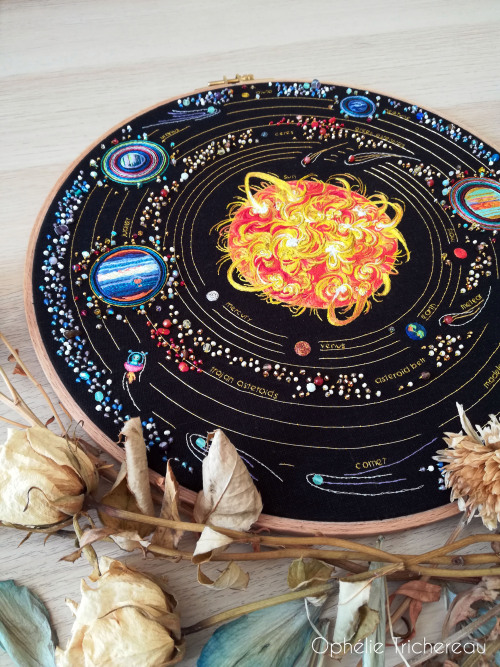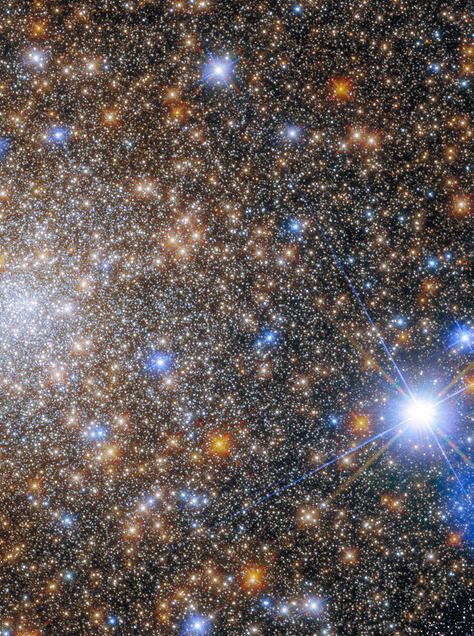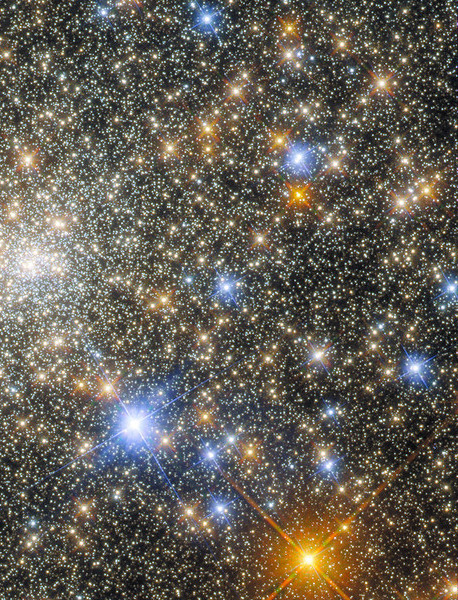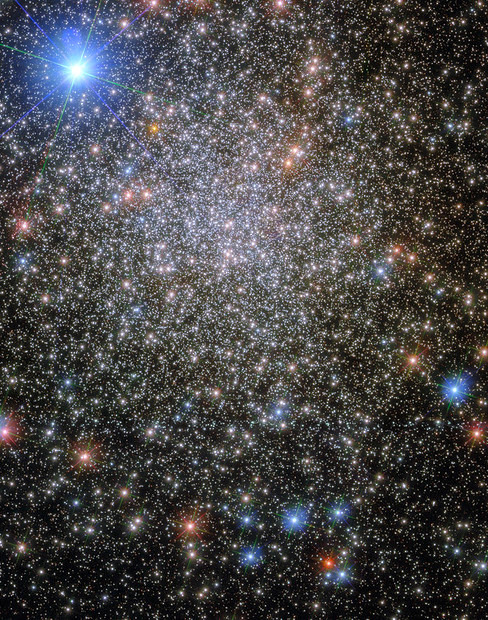NGC 1569, Star Sparks

NGC 1569, Star Sparks
More Posts from Ad-astra-affecte-spe and Others

L1527 IRS - Protostar
Stars form when bodies of dust and gas create enough mass to create a gravitational effect that's able to then pull in more gas, the process continues and the mass increases until the pressure at the centre is sufficient for fusion to begin.
There's many examples of protostars, in fact back in 2012, NASA’s Spitzer Space Telescope focused in on L1527 IRS, believed at the time to be the youngest forming star ever found.

Recently, the JWST re-visited this protostar, and the title image was the result.
The forming star cannot be visually spotted, but is thought to be around 20-40% the mass of our own Sun already.

If you look closely, you can see there's a dark patch in the centre, this is actually the accretion disk around the newly formed star, what is left over after the formation, may go on to form the planets, in fact, they may be actually starting to be created already, as recent evidence does point to planets being born around the same time as the star does in many cases.
The protostar is only 450 light years from Earth in the Constellation of Taurus, and is thought to be around 100,000 years old, a blink of an eye in the life of a star, particularly of this mass.
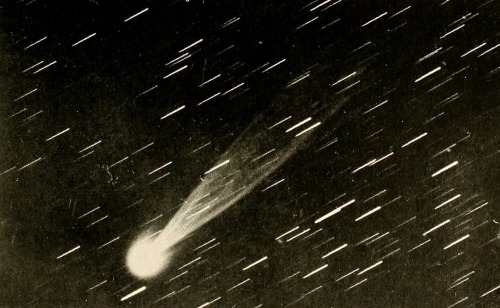



A beginner’s star-book, an easy guide to the stars and to the astronomical uses of the opera-glass, the field-glass and the telescope, 1912

M85 (center right) and NGC 4394 (center left) // Bart Delsaert
M85 is an elliptical galaxy, but one that has a complex series of shells and ripples. These features are thought to have been created some 4-7 billion years ago when it merged with another galaxy. It is currently interacting with the barred spiral galaxy NGC 4394, which might be supporting the shells' structure.
This galaxy was an original discovery of Méchain's in 1781 and is an isolated member of the Virgo Cluster, about 60 million light years away.


A solar eclipse seen from space.

The night side of Saturn's largest moon, Titan. Sunlight scatters through Titan's atmosphere, forming purple and gray rings l NASA Cassini

The original Voyager 1 "Blue Movie" which records its approach during a period of over 60 Jupiter days (January 6 - February 3, 1979)
-
 carlottaragazzaloveeur reblogged this · 1 month ago
carlottaragazzaloveeur reblogged this · 1 month ago -
 carlottaragazzaloveeur liked this · 1 month ago
carlottaragazzaloveeur liked this · 1 month ago -
 oniroxameni liked this · 8 months ago
oniroxameni liked this · 8 months ago -
 ciruellas reblogged this · 9 months ago
ciruellas reblogged this · 9 months ago -
 variatio-delectat liked this · 10 months ago
variatio-delectat liked this · 10 months ago -
 godddawful reblogged this · 11 months ago
godddawful reblogged this · 11 months ago -
 bi-hans liked this · 1 year ago
bi-hans liked this · 1 year ago -
 gregorlenko liked this · 1 year ago
gregorlenko liked this · 1 year ago -
 v-m-smith reblogged this · 1 year ago
v-m-smith reblogged this · 1 year ago -
 kanazawa002 liked this · 1 year ago
kanazawa002 liked this · 1 year ago -
 sheliesshattered reblogged this · 1 year ago
sheliesshattered reblogged this · 1 year ago -
 kaithegremlin liked this · 1 year ago
kaithegremlin liked this · 1 year ago -
 bunnygladstone liked this · 1 year ago
bunnygladstone liked this · 1 year ago -
 v-m-smith liked this · 1 year ago
v-m-smith liked this · 1 year ago -
 dyskomike reblogged this · 1 year ago
dyskomike reblogged this · 1 year ago -
 dyskomike liked this · 1 year ago
dyskomike liked this · 1 year ago -
 virginlibertine reblogged this · 1 year ago
virginlibertine reblogged this · 1 year ago -
 virginlibertine liked this · 1 year ago
virginlibertine liked this · 1 year ago -
 goatpanic liked this · 1 year ago
goatpanic liked this · 1 year ago -
 skarlettriott reblogged this · 1 year ago
skarlettriott reblogged this · 1 year ago -
 messier47 reblogged this · 1 year ago
messier47 reblogged this · 1 year ago -
 xxhot-mindsxx85 reblogged this · 1 year ago
xxhot-mindsxx85 reblogged this · 1 year ago -
 dothemindything liked this · 1 year ago
dothemindything liked this · 1 year ago -
 metalzoic liked this · 1 year ago
metalzoic liked this · 1 year ago -
 kneltnotbowed reblogged this · 1 year ago
kneltnotbowed reblogged this · 1 year ago -
 dragon-monarch reblogged this · 1 year ago
dragon-monarch reblogged this · 1 year ago -
 beautiful-and-dread reblogged this · 1 year ago
beautiful-and-dread reblogged this · 1 year ago -
 gorewound liked this · 1 year ago
gorewound liked this · 1 year ago -
 l1v32d13-d132l1v3 reblogged this · 1 year ago
l1v32d13-d132l1v3 reblogged this · 1 year ago -
 bigangrymonkey liked this · 1 year ago
bigangrymonkey liked this · 1 year ago -
 airhead-the-wise liked this · 1 year ago
airhead-the-wise liked this · 1 year ago -
 memyselfmoi liked this · 1 year ago
memyselfmoi liked this · 1 year ago -
 nobodyowens2514 liked this · 1 year ago
nobodyowens2514 liked this · 1 year ago -
 zealousstudentpartycookie liked this · 1 year ago
zealousstudentpartycookie liked this · 1 year ago -
 26lsworld liked this · 1 year ago
26lsworld liked this · 1 year ago -
 k-llewellin-novelist reblogged this · 1 year ago
k-llewellin-novelist reblogged this · 1 year ago -
 starsgivemehp reblogged this · 1 year ago
starsgivemehp reblogged this · 1 year ago -
 thesirenscallmelo liked this · 1 year ago
thesirenscallmelo liked this · 1 year ago -
 sidewalkchemistry reblogged this · 1 year ago
sidewalkchemistry reblogged this · 1 year ago -
 crystariumrose reblogged this · 1 year ago
crystariumrose reblogged this · 1 year ago -
 zeal-aether reblogged this · 1 year ago
zeal-aether reblogged this · 1 year ago -
 puddleofwheat reblogged this · 1 year ago
puddleofwheat reblogged this · 1 year ago -
 shizukais liked this · 1 year ago
shizukais liked this · 1 year ago -
 celeste-tyrrell reblogged this · 1 year ago
celeste-tyrrell reblogged this · 1 year ago

★•Astronomy, Physics, and Aerospace•★ Original and Reblogged Content curated by a NASA Solar System Ambassador
204 posts






